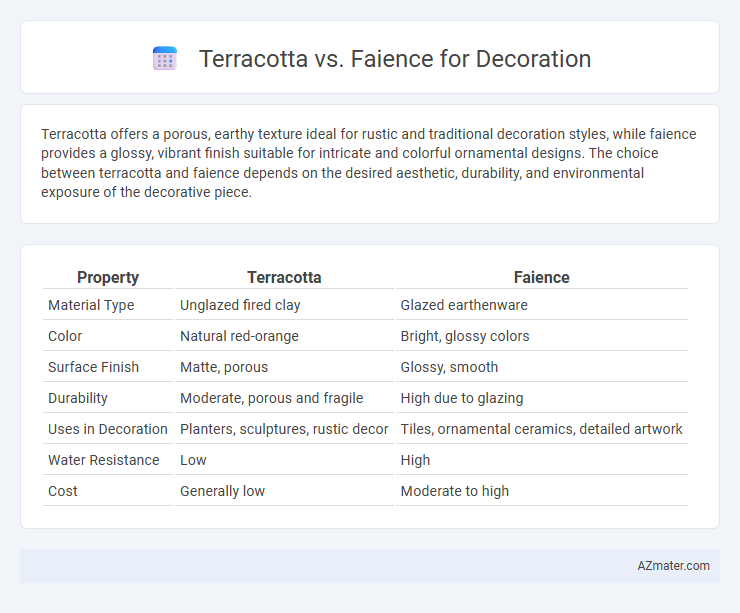Terracotta offers a porous, earthy texture ideal for rustic and traditional decoration styles, while faience provides a glossy, vibrant finish suitable for intricate and colorful ornamental designs. The choice between terracotta and faience depends on the desired aesthetic, durability, and environmental exposure of the decorative piece.
Table of Comparison
| Property | Terracotta | Faience |
|---|---|---|
| Material Type | Unglazed fired clay | Glazed earthenware |
| Color | Natural red-orange | Bright, glossy colors |
| Surface Finish | Matte, porous | Glossy, smooth |
| Durability | Moderate, porous and fragile | High due to glazing |
| Uses in Decoration | Planters, sculptures, rustic decor | Tiles, ornamental ceramics, detailed artwork |
| Water Resistance | Low | High |
| Cost | Generally low | Moderate to high |
Introduction to Terracotta and Faience
Terracotta is a porous, clay-based ceramic material widely used for ornamental and architectural decorations due to its earthy texture and warm reddish-brown color. Faience, on the other hand, is a glazed non-clay ceramic made primarily from quartz or sand, known for its bright, glossy surface and vibrant hues, often used in ancient Egyptian and Mediterranean decor. Both materials offer unique aesthetic qualities and durability, making them popular choices in decorative arts and historic restoration projects.
Historical Background of Terracotta and Faience
Terracotta, dating back to ancient Mesopotamia around 3000 BCE, was widely used for pottery, sculpture, and architectural decoration due to its durability and earthy hues. Faience, emerging in ancient Egypt circa 4000 BCE, is a glazed non-clay ceramic material prized for its bright, lustrous colors and symbolic significance in jewelry and small decorative objects. Both materials reflect distinct cultural techniques, with terracotta embodying utilitarian and artistic functions, while faience showcases early advancements in glazing and vibrant aesthetics.
Material Composition and Manufacturing Process
Terracotta is made from natural clay that is shaped and fired at relatively low temperatures, resulting in a porous and earthy material ideal for rustic or traditional decorations. Faience, in contrast, consists of a powdered quartz base combined with alkali and fired at higher temperatures, producing a glassy, brightly glazed surface favored for intricate, colorful designs. The manufacturing process of terracotta involves simple molding and kiln firing, while faience requires precise glazing techniques and controlled firing to achieve its characteristic glossy finish and vibrant hues.
Visual Appearance and Texture Comparison
Terracotta offers a warm, earthy appearance with a matte, porous texture that enhances rustic and traditional decor styles, while faience presents a glossy, smooth surface characterized by bright, vibrant colors and intricate patterns ideal for ornamental and refined settings. The unglazed finish of terracotta provides a natural, tactile feel often used in sculptural and pottery work, contrasting sharply with the glazed, glass-like finish of faience, which reflects light and highlights detailed artistry. Choosing between the two depends on the desired aesthetic: terracotta emphasizes organic, muted tones and rough textures, whereas faience delivers a polished, colorful, and decorative appeal.
Durability and Longevity in Decorative Use
Terracotta offers high durability in decorative use due to its dense, fired clay composition, making it resistant to weathering and wear over time. Faience, characterized by its glazed, porous surface, provides vibrant colors but is more prone to chipping and deterioration under harsh environmental conditions. For long-term decorative applications exposed to the elements, terracotta generally ensures greater longevity compared to the more delicate faience.
Color Variations and Glazing Techniques
Terracotta offers warm, earthy color variations ranging from reddish-brown to burnt orange, achieved through natural clay firing, while faience presents vibrant, opaque glazes in bright blues, greens, and yellows due to its tin-glazed surface. The glazing techniques for terracotta typically involve matte or lightly glazed finishes enhancing its rustic texture, whereas faience utilizes a glossy, glass-like glaze applied over a porous ceramic body to create strikingly vivid, smooth decorations. These contrasting approaches influence both the aesthetic appeal and durability, with faience's sheen and color intensity providing a more decorative and polished look compared to terracotta's organic, textured finish.
Artistic Applications in Modern and Traditional Decor
Terracotta offers a warm, earthy aesthetic with its porous, unglazed surface ideal for rustic and Mediterranean-style interiors, while faience features a glossy, tin-glazed finish that brings vibrant colors and intricate patterns suited for Mediterranean and Moorish-inspired decor. Artists favor terracotta for sculptural elements and textured pottery, whereas faience is preferred for decorative tiles and ornate panels that enhance both traditional and contemporary settings. Both materials provide versatile artistic applications, making them valuable for blending historical craftsmanship with modern design trends.
Maintenance and Cleaning Requirements
Terracotta requires regular sealing to prevent moisture absorption and stains, making maintenance relatively high compared to faience, which is glazed and naturally resistant to water and dirt. Faience surfaces can be cleaned easily with mild soap and water without the need for special treatments, offering low-maintenance durability. Terracotta's porous nature necessitates careful cleaning to avoid damage, whereas faience's smooth, non-porous finish ensures longevity with minimal upkeep.
Cost-Effectiveness for Decorative Projects
Terracotta offers a highly cost-effective option for decorative projects due to its natural clay composition, which is widely available and inexpensive to produce. Faience, consisting of glazed ceramic with a more complex manufacturing process, generally incurs higher material and labor costs, making it less budget-friendly. For large-scale or budget-conscious decorative installations, terracotta provides durability and aesthetic appeal at a fraction of the price compared to faience.
Choosing Between Terracotta and Faience: Key Considerations
Choosing between terracotta and faience for decoration involves evaluating durability, texture, and aesthetic appeal. Terracotta offers a rustic, porous surface ideal for warm, earthy designs, but requires sealing to prevent moisture damage. Faience provides a glossy, colorful finish with greater resistance to water and stains, making it suitable for intricate patterns and vibrant accents.

Infographic: Terracotta vs Faience for Decoration
 azmater.com
azmater.com